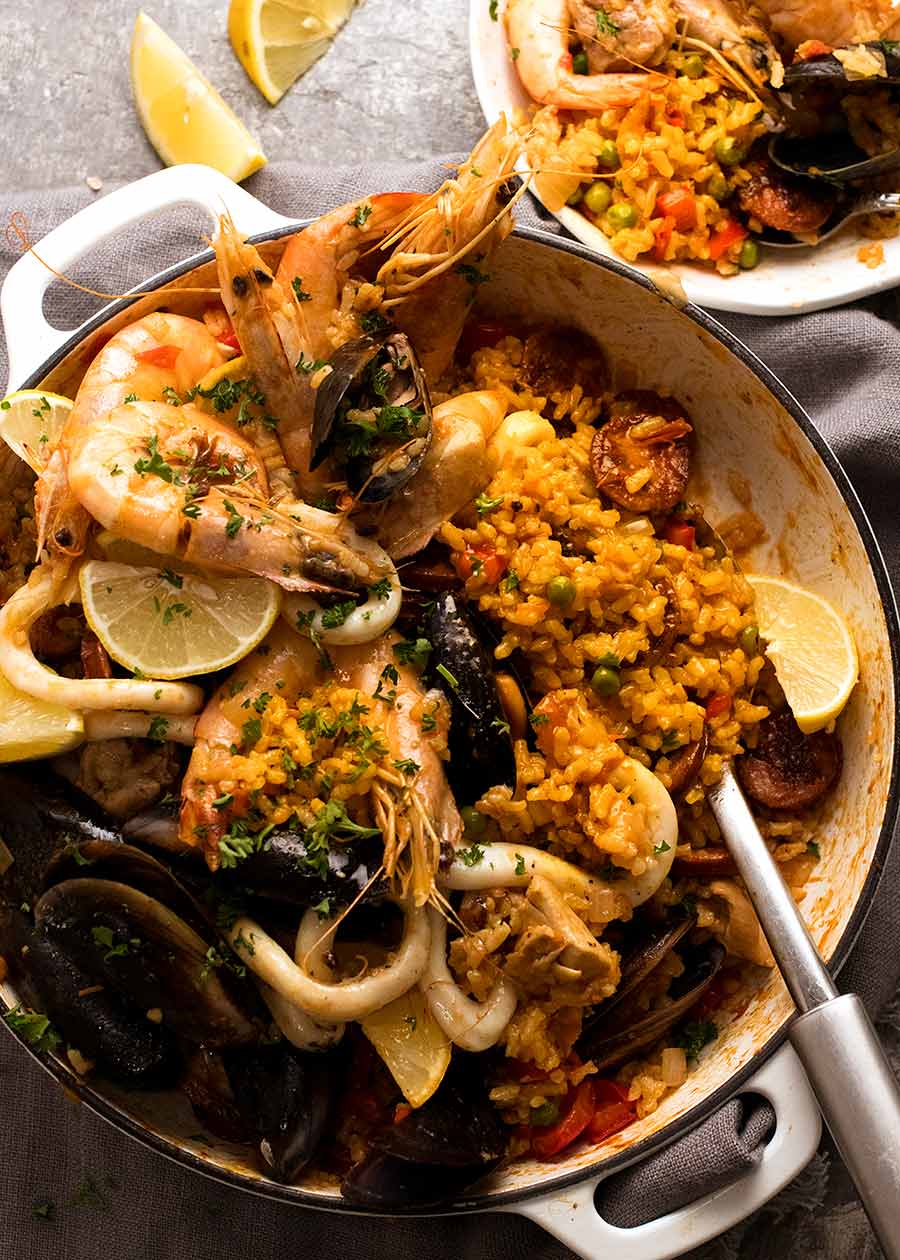
Paella! This famous saffron infused rice dish is a traditional Spanish recipe that comes fully loaded with seafood or anything your heart desires! You don’t need a paella pan to cook paella, any skillet or even a large pot will do, and it’s surprisingly straightforward to make.
Terrific festive party food!

Paella recipe
If you’ve always wanted to but been too afraid to try Paella, I can assure you – there is no reason to be scared! If you approach it the right way – and I like to keep my recipes as risk free as possible – you will end up with rice that’s cooked exactly to your taste in a saffron infused, flavour loaded sauce with all your seafood cooked to perfection.
No overcooked seafood, and no mushy rice around here!
The beauty of paella is that it is in fact extremely flexible. Don’t get too hung about about getting the exact seafood I use. Don’t listen to the authors who tell you that you MUST use homemade fish broth or buy extremely expensive seafood stock.
I learnt Paella the Migeul Maestro* and Rick Stein way – as he wrote in his Mediterranean Escapes cookbook, Paella, whether it be for a quick midweek meal or a large festive gathering, is meant to be relaxed and fun, not stressful with strict rules.
So just chill out!! 
* Miguel Maestro is Australia’s most well known Spanish Chef.

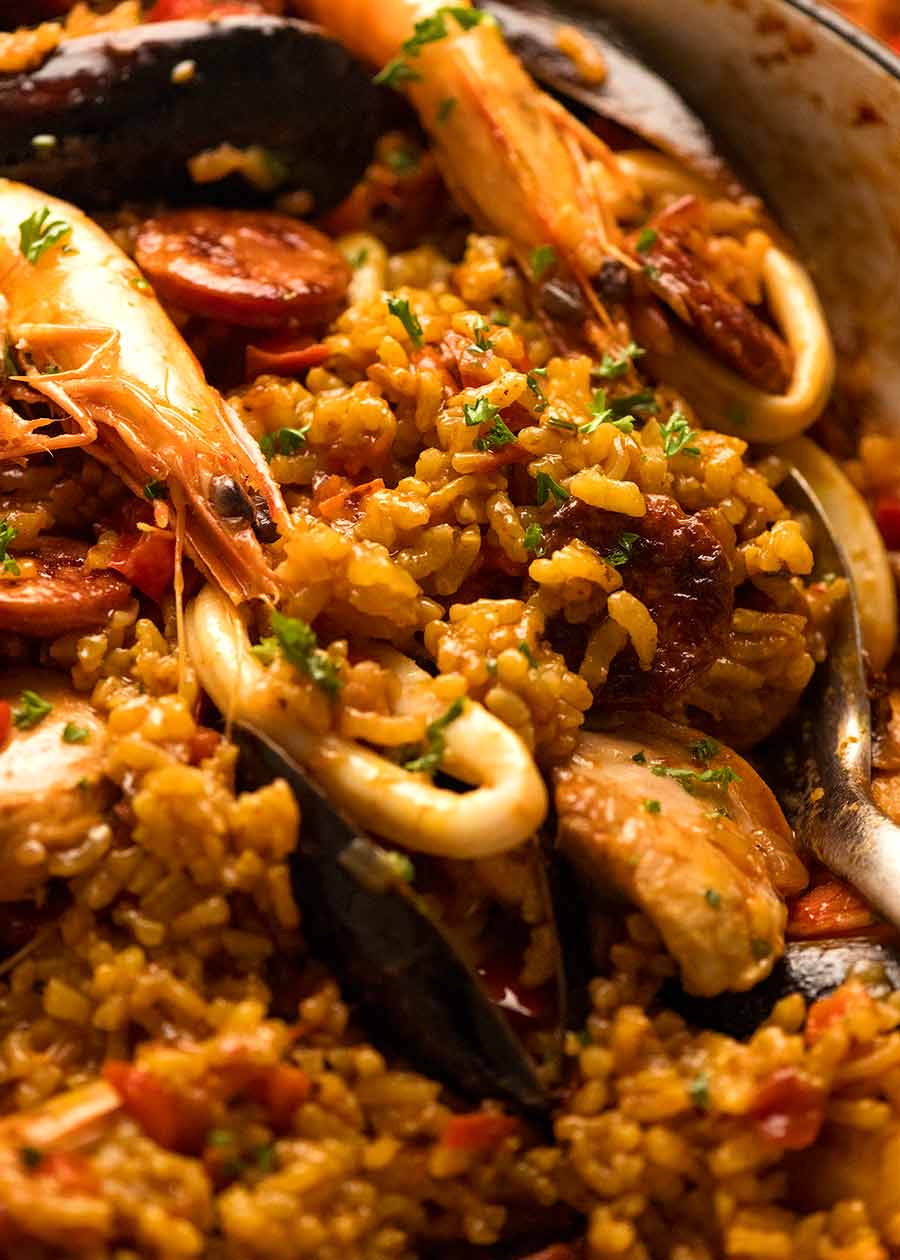
I say this is a straightforward recipe but I AM going to spend a bit more time on explaining steps and process visuals than I usually do (short recipe video extremely helpful for first timers) because I’m guessing paella is a bit of a special occasion dish for many and I want to ensure you nail it! (And you will, I promise – if you follow my steps!)
Best rice to use for paella
The best rice to use for paella is Spanish rice labelled as:
Bomba Rice – or arroz bomba (“arroz” means rice in Spanish);
Valencia rice or Arroz de Valencia (pictured below) – the other common name for Bomba Rice; or
Calasparra Rice -or Arroz Calasparra.
Paella price packets tend to be very helpful providing clues such as pictures of Paella or “perfect for paella!” splashed across it. 
Where to find paella rice – here in Australia, paella rice is sold at most Woolworths and Harris Farms, some Coles, delis, Spanish or Mediterranean delis (some Italian ones too), or gourmet stores. See below for best subs using more common rice.
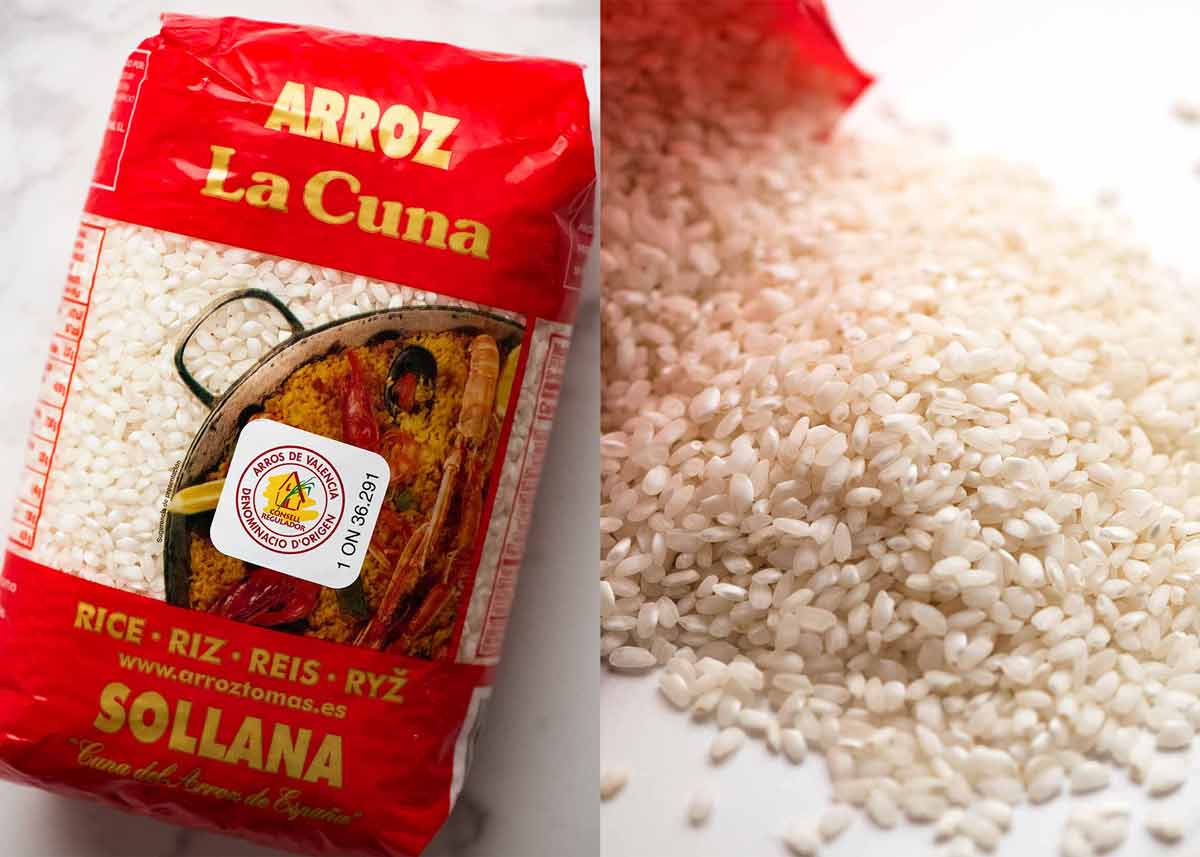
Paella rice is a short grain variety of rice (ie it is short in length, distinctly different from basmati which is very long). The unique quality of paella rice is that it absorbs more liquid than types of rice without getting bloated and mushy, making it ideal for a dish like paella where you want the rice to absorb loads of flavour.
Best substitute for paella rice is risotto rice (arborio rice) which has similar characteristics ie. ability to absorb lots of liquid, except risotto goes creamy if you stir it. The next best is medium grain rice – the same rice I use for rice pudding.
I do not recommend using: brown rice, long grain white rice, black rice, wild rice or any other fancy type of rice. And in anticipation of someone asking – NO to quinoa!!! (A million Spaniards almost fainted at the thought).
What goes into Paella
I divide the stuff that goes into Paella into 2 groups:
The Base Ingredients – rice, aromatics (garlic, onion, saffron), stock;
The Add Ins – chicken, seafood, chorizo
1. The Base Ingredients
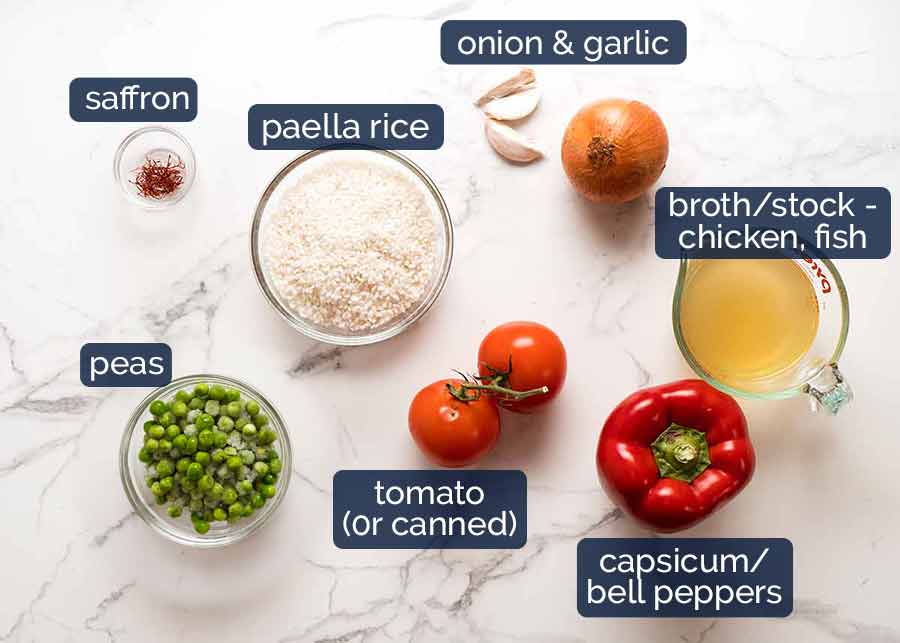
Paella rice – as discussed above. Buy anything labelled as Bomba, Valencia, de Valencia or Calasparra – or simply “paella rice”!
Saffron – a signature part of paella is the warm yellow tinge of the rice and delicate saffron flavour. Saffron is expensive, even more expensive than gold by weight! So if your budget won’t stretch to real saffron threads, use a pinch of saffron powder (it’s artificial but will provide the same colour hit and some flavour – but don’t worry, we have tons of other flavour in this paella!);
Stock/broth – just store bought chicken stock is fine here, we are going to get tons of seafood stock from the seafood we use. If you’re in Australia and insist on using fish or seafood stock, get the good stuff from gourmet or fish shops, do not buy supermarket bottles (they are quite nasty). If you’re in US, I can highly recommend clam juice as an option if you want extra seafood flavour;
Garlic and onion – essential flavour base;
Tomato – fresh tomato is the traditional method but if you can’t get good juicy fresh tomato (as I couldn’t when I filmed the video), use canned instead;
Capsicum/bell peppers – also adds to the flavour base, I really recommend using it;
Peas – optional, I like that it adds a terrific splash of colour.
2. The Add Ins
And here’s the proteins I put IN the paella – chicken, chorizo*, calamari, prawns/shrimp, mussels.
* 45 million Spaniards just threw up their hands in protest at the inclusion of Chorizo, declaring it’s not traditional! But outside of Spain, it’s considered a key ingredient – and it adds a ton of flavour to the dish. So I’d never consider leaving it out!
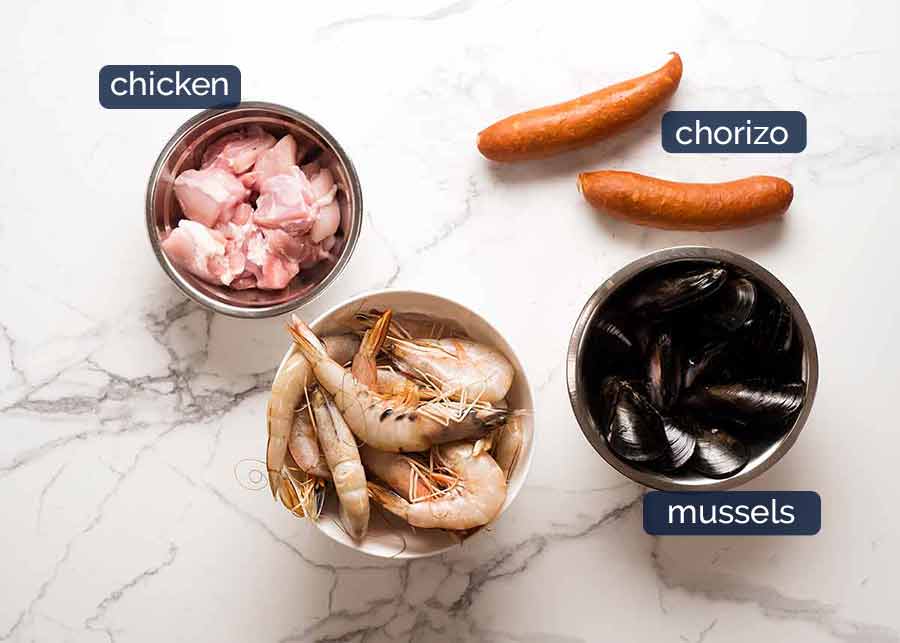
Forgot to include calamari in the above photo! if you don’t find rings, buy a squid tube then slice it – as pictured below.
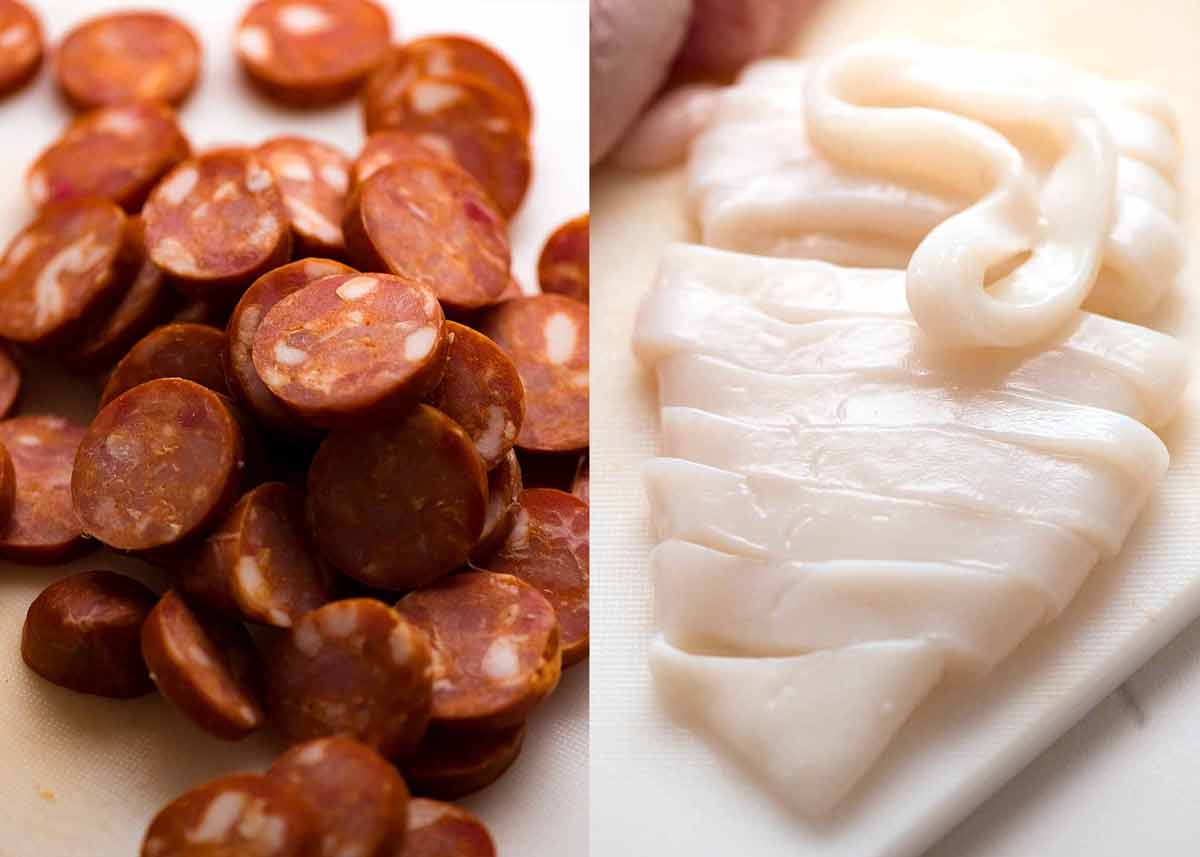
How to make paella
Here’s how to make paella in 4 simple steps:
sear chorizo and squid first, then remove;
sauté onion and garlic, brown chicken, then cook the rice in the broth with some of the chorizo;
partway through cooking the rice, quidge the prawns/shrimp and mussels in which will leech a STACK of juices into the rice, adding loads of flavour; and
pop squid back on top, then cover and rest for 5 minutes before serving!
Part 1 – sear, make flavour base, add rice and stock
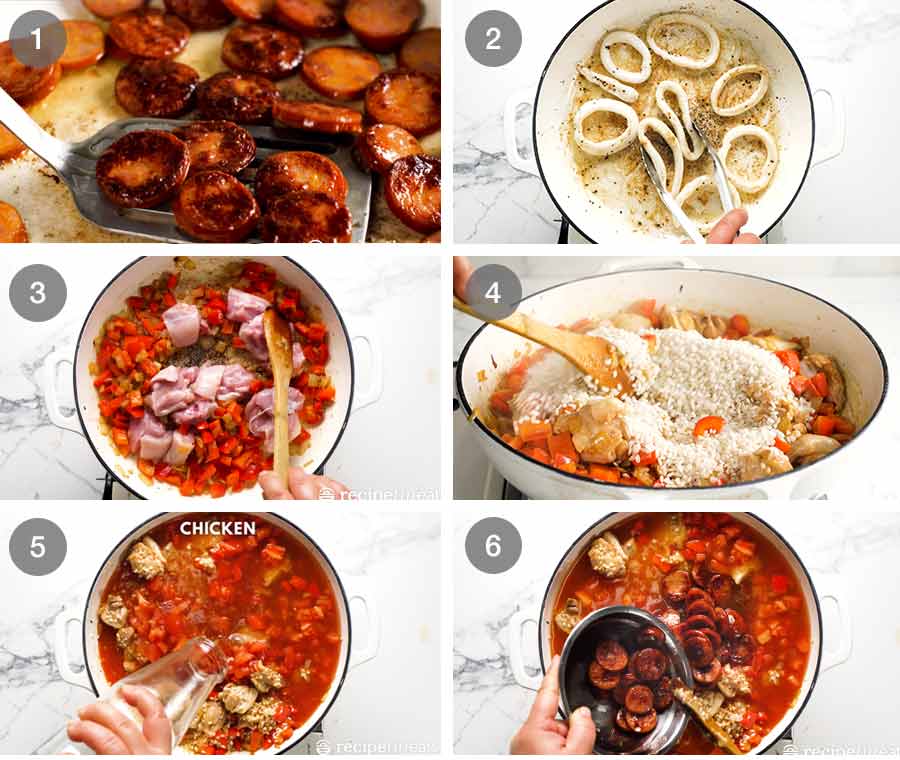
This part is pretty straightforward. The only key tip here is to only cook the squid/calamari for 90 seconds – squid cooks super fast and goes rubbery quite quickly!
You don’t need a paella pan. Any large skillet will work fine – or even a wide pot. In fact, paella pans require more advanced cooking skills because the everyday paella pans tend to be quite thin which makes the rice very prone to burning unless you have a stove burner made especially for paella (they have wide rings that turn down pretty low).
Note how we return some of the cooked chorizo back in to cook with the rice. It adds great flavour into the dish as well as salt.
Part 2 – cook rice, squidge in seafood
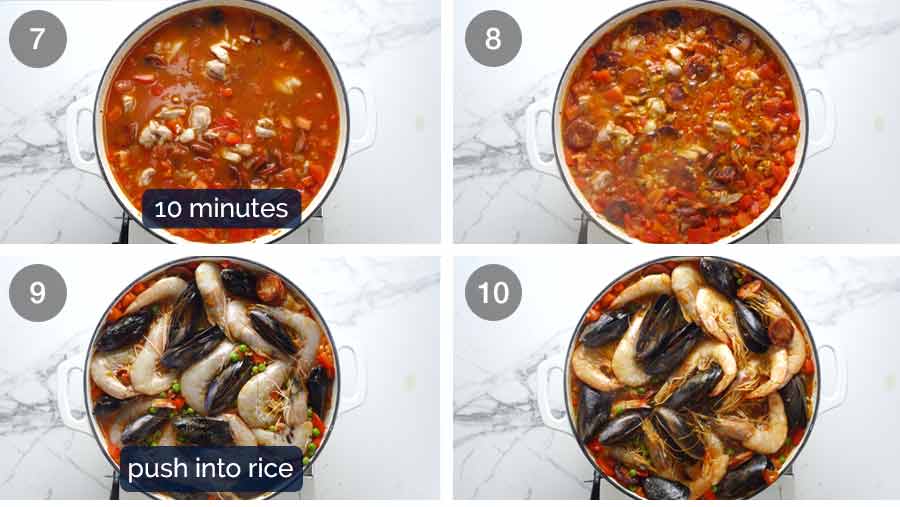
The rice gets cooked uncovered (this is a distinct cooking technique for paella compared to other iconic rice dishes of the world like Jambalaya and Biryani) for 10 minutes. At this stage, it will be partially cooked though it will seem to absorb most of the liquid.
But wait! There’s more liquid to come!
We add the prawns and mussels partway through cooking the rice because they cook faster. If you added them at the beginning, they would overcook. Nobody wants rubbery prawns in their paella!
Together (but especially the mussels) they will leech an astonishing amount of liquid as they cook – around 3/4 of a cup. Not only does this provide the extra liquid required to finish cooking the rice, it’s essentially our very own homemade seafood stock that adds a load of incredible flavour into our paella!
Part 3 – garnish and rest!
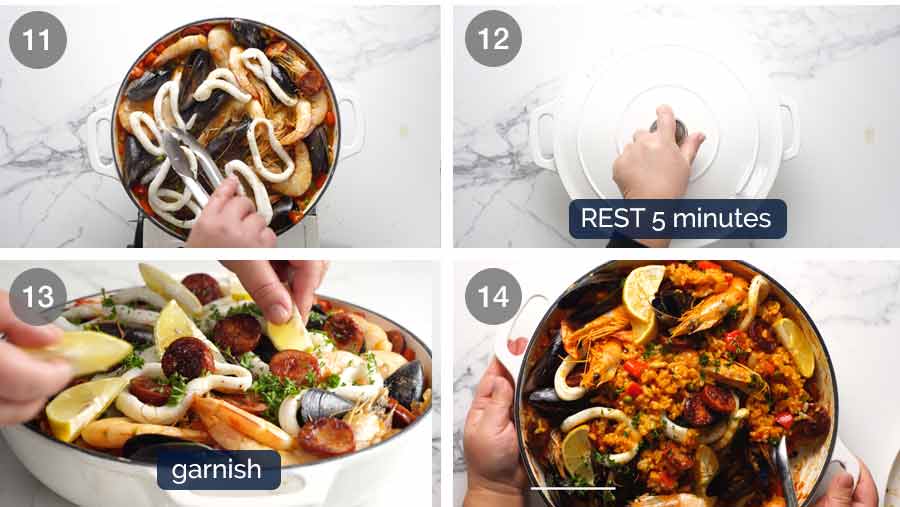
The home stretch! After 8 minutes, the prawns will be perfectly cooked and the mussels will be open so you know they’re cooked.
You will need to taste the rice to ensure it’s perfectly cooked (I know, I know, what an inconvenience!  ). And it will still be a bit liquidy which is exactly what you want – because now we’re going to cover and rest it off the heat, during which time the excess liquid will be absorbed, leaving you with a bit pot of juicy paella rice, ready for serving!
). And it will still be a bit liquidy which is exactly what you want – because now we’re going to cover and rest it off the heat, during which time the excess liquid will be absorbed, leaving you with a bit pot of juicy paella rice, ready for serving!
Pop the cooked squid and reserved garnishing chorizo back on top before you cover it so the heat warms them through.
And just prior to serving, add some wedges of lemon and a sprinkle of parsley for colour!
How to serve paella
It’s entirely up to you whether you take it to the table as it is with the seafood complexly covering the rice, or whether you give it a bit of a mix so the seafood gets jumbled through the rice a bit.
I tend to give it a bit of a mix to loosen the rice a bit, mix the flavour through a bit better and also disperse the seafood through. So I bring it to the table looking like this:
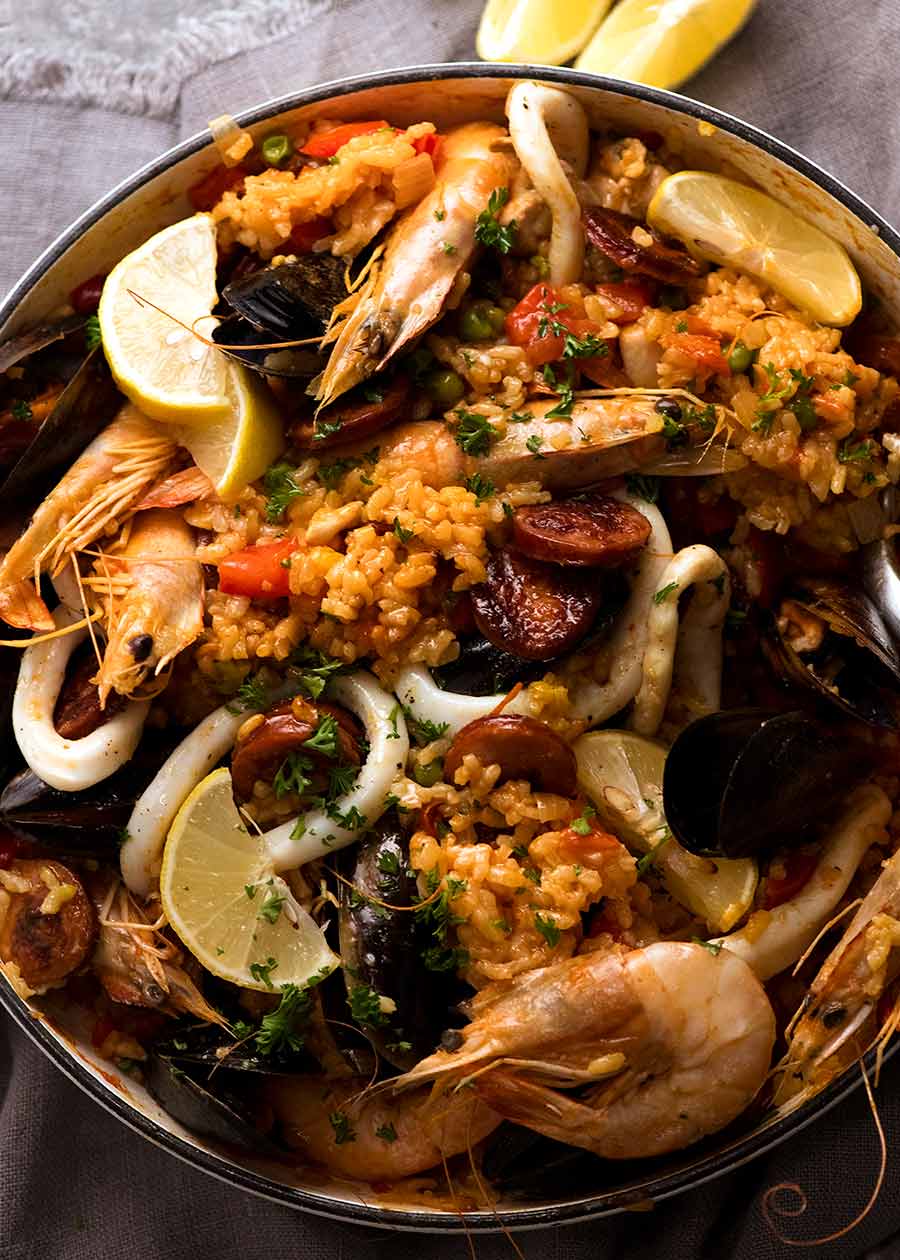
How much to make per person
Paella is such a great dish for a gathering because it’s easy to make loads in a giant pan or get multiple pans going at the same time! Use the scaler function on the recipe card to increase servings.
Allow for 1/3 cup / 60g of rice per person, plus around 150g / 5 oz of proteins and seafood. This is slightly on the generous side – but leftovers keep well, and nobody wants to be short!
PAELLA COOKING TIPS
Answering your burning questions about making Paella. 
What rice to use for Paella? The best rice for paella is Bomba rice, also labelled as Valencia Rice or Rice de Valencia (Valencia is the region that Paella is said to have originated from). The other common rice is called Calasparra Rice (a region in Spain where it is grown). See above in post for more information.
Best paella pan / skillet – Paella pans are large and shallow so the rice spreads out thinly and cooks evenly without stirring. But you don’t need a paella pan to make paella! Just use a large skillet. The key is to ensure the rice is not stacked up more than about 2 cm / 3/5″ deep (excluding the liquid & seafood added later, but including onion etc mixed throughout rice), to ensure even cooking.
Avoiding mushy rice – This part is EASY!!! Just start with the liquid ratios I’ve provided in the recipe which will yield a tender but firm rice which is how I like it. Once the liquid is absorbed, if the rice is not as soft as you like, just add a drizzle of hot tap water over the top of the rice (1/2 cup at a time), then leave to absorb for a few minutes until the rice is cooked to your taste. The strict rule is 3 cups of liquid to 1 cup of paella rice. I use a bit less because the seafood (especially mussels) in seafood paella releases plenty of liquid.
Cook in broth, not water – Fact is, the better the broth, the better the paella. The best is a homemade seafood broth. The 2nd best is a store bought chicken broth dolled up by simmering it for a while with some seafood offcuts, or make seafood paella like I have (so the flavoured seafood juices drop into the rice). The 3rd best is store bought chicken broth. Store bought fish stock doesn’t make the cut in my world – sorry.  (Unless of course, you get a gourmet homemade one.)
(Unless of course, you get a gourmet homemade one.)
Don’t stir!! Unlike risotto, paella should not be creamy. So once you add the broth, do not stir. The best paellas have a golden crust on the bottom, called the soccarat, and it’s the best part of the paella. 
Add seafood partway through cooking – Paella takes 20 to 25 minutes to cook. So squidge the seafood in partway through cooking to avoid overcooking it. Even partially submerged, it is enough heat to cook. The only exception is squid – it needs to be cooked super fast (2 minutes or less) or super long to make it tender (60 minutes). Anything in between is horrid and rubbery. For paella, we take the super fast route – cook it first, remove, add back later.
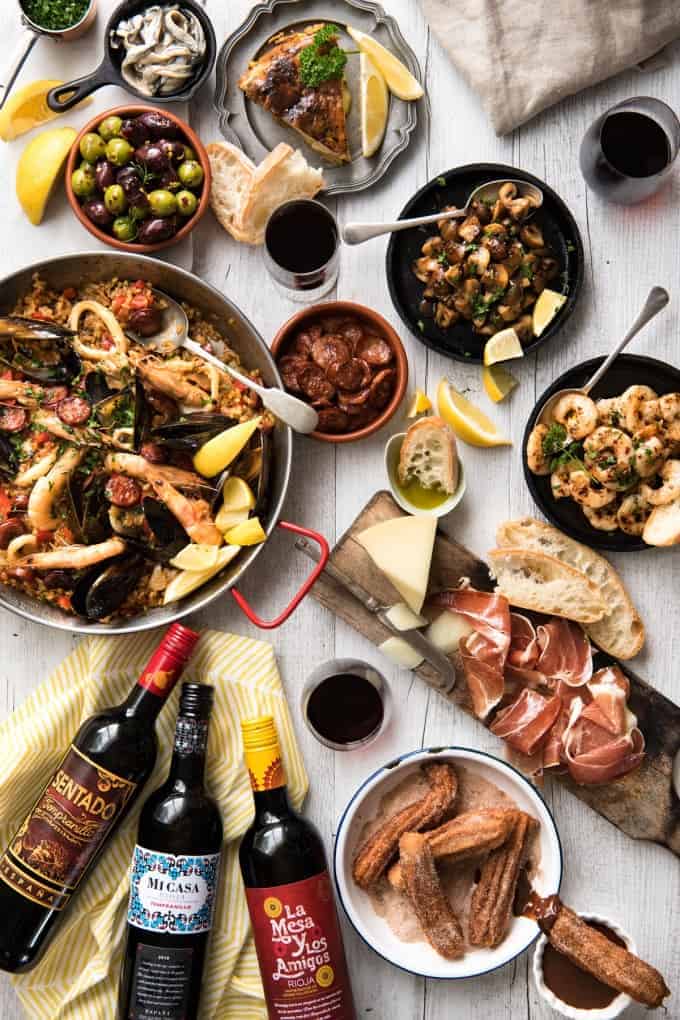
What to serve with Paella
Back in 2016, in my pre recipe video days, I shared this Paella recipe as part of a 3 course Spanish Fiesta! So here are some suggestions to make a full Spanish Feast:
Easy Tapas Starters – garlic mushrooms, Spanish potato tortilla, and more! (No recipe video for these, being that they’re old recipes. If you want videos, put in a request in the comments section below!)
This paella for the main
Spanish CHURROS for dessert! Astonishingly straightforward to make – 20 minutes start to finish – and they also reheat extremely well which makes them great make ahead party food!
So. Much. Food.
So, SO happy! – Nagi x
Watch how to make it
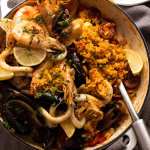
Spanish Paella
Recipe video above. The most famous Spanish dish of them all! Paella is meant to be a fun relaxed dish, so don't get hun up about having the exact same add ins I've used. And don't be scared to make it – paella is actually very forgiving if you have the right liquid/rice ratios and follow the order in which I cook things!Note on Chorizo – NOT in true Spanish Paella recipes however, it's widely used in Spanish restaurants outside of Spain. Australia would faint if I excluded it. So it's in!
Course DinnerCuisine SpanishKeyword paella recipe, seafood paella, spanish paella
Prep Time 15 minutesCook Time 30 minutesTotal Time 45 minutes
Servings 5 – 6 people
Calories 692kcal
Author Nagi | RecipeTin Eats
Ingredients1 – 2 tbsp olive oil7 oz / 200g chorizo (2 pieces) , sliced 1/2 cm / 1/5" thick (Note 1)200g / 6 oz squid (calamari) , cut into 7mm / 1/4" thick rings (Note 2)1 onion , diced (brown, white, yellow)3 garlic cloves , minced1 red capsicum / bell pepper , diced1 1/2 cups paella rice ("Bomba", "Valencia" or "Calasparra" rice) (Note 3)2 juicy ripe tomatoes, peeled and diced OR 3/4 cup canned crushed tomato (Note 4)300g / 10 oz chicken thigh fillets , cut into 1.5" / 3.5cm pieces3 1/2 cups chicken broth/stock (not low sodium) or homemade seafood broth (Note 5)1 tsp saffron threads (or 1/4 tsp ground saffron, Note 6)1 cup frozen peas12- 16 medium / large prawns , whole (shell on) (Note 7)12 large mussels (Note 8)GarnishFresh parsley , chopped2 Lemons , cut into wedgesCups – Metric
InstructionsChorizo – Heat 1 tbsp oil in a 30cm / 10" paella pan or large skillet over high heat (Note 9). Add chorizo and cook until browned on each side (~ 3 minutes). Remove with a slotted spoon and set aside.Squid – Add squid and cook for 45 seconds on each side, then remove and set aside.Garlic, onion, capsicum – Add remaining oil (if needed). Add garlic and onion, cook for 2 minutes. Add capsicum, cook for 1 minute.Chicken – Add chicken. Cook for 2 minutes until lightly browned but still raw inside.Add Rice – Add rice and mix until the grains are coated in oil.Cooking broth – Add in most of the chorizo (reserve some for garnish), chicken stock, fresh or crushed tomato and saffron. Stir.Simmer 1 – Bring it to a simmer then adjust heat so it's simmering fairly gently (not super rapidly, will burn rice). Simmer for 10 minutes – no stirring! At this stage, a bit of rice should be poking through to the surface but there should still be plenty of liquid.Add peas, prawns and mussels – Scatter over peas, squidge the prawns and mussels into the rice (partial submerge is fine). Simmer 2 – Cook for 8 minutes (turn prawns halfway if you think it's necessary) or until prawns are opaque, mussels are open, and most of the liquid has been absorbed but still a bit liquidy. Discard any mussels that do not open. Remove from stove. Check rice – Do a taste test to see if the rice is cooked – it should be firm but cooked. If it is too firm for your taste, no stress, just add a splash of hot water (not too much!) and keep cooking. Rest – Scatter over squid and reserve chorizo (residual heat will warm through), cover with lid then rest for 5 minutes (rice will absorb remainig liquid). Paella rice should now be tender but "juicy", not stodgy and thick (if it is, add splash of water to loosen it).Garnish – scatter with parsley and wedges of lemon. Take to table as is, then mix up rice with seafood before serving!
NotesNo salt? You’ll find if you follow the recipe as is, it is well seasoned from the chorizo, full salt chicken stock (not low salt) and the seafood. When you taste at the end, if you want it saltier, add a sprinkle before you mix it all up for serving.
1. Chorizo – make sure you get cured chorizo (ie already cooked) not raw chorizo (ie like raw sausage, won’t slice neatly).
2. Squid / calamari – often sold pre sliced, or buy a tube a slice (as pictured in post).
3. Rice – paella best made with paella rice. Get anything labelled: “Bomba, Calasparra, Valencia or de Valencia, or paella rice”. It will probably have the word “Arroz” next to it which means “rice” in Spanish. (Australia – sold at large Woolies, some Coles, all Harris Farms, Spanish / Euro delis, gourmet stores).
The liquid to rice ratio guide for cooking paella rice is 1 cup of rice to 2.5 cups of liquid (for tender but firm, my preference) or 3 cups for soft rice. I use slightly less than 2.5 cups per 1 cup rice in this recipe because seafood drops a lot of liquid (especially mussels). Nobody wants mushy overcooked paella rice!
If you DO NOT USE seafood, increase the liquid in this recipe to 3 3/4 cups / 925 ml for the 1 1/2 cups rice (because seafood leeches plenty of liquid).
Best substitutes for paella rice:
risotto rice – but add an extra 1/2 cup of water with stock
medium grain rice – reduce water to 2 cups per 1 cup of rice (ie use 3 cups stock for 1/5 cups rice)
long grain white rice, sushi rice – will work per medium grain rice, but finished dish mouthfeel quite different to paella (still tasty though!)
For each of these, if the rice is still too firm at the end, just add water 1/2 cup at a time and keep cooking.
Do not use: brown rice (takes too long to cook), basmati (too firm) or jasmine rice (too mushy), wild rice (too firm), black rice (too fancy  ). Do not ask about quinoa (the answer is NO!
). Do not ask about quinoa (the answer is NO! )
)
4. Tomato – diced fresh tomato is traditional, but if you can’t find juicy ones (as I couldn’t when I went to film the video) use canned instead.
5. Stock/broth – The better the stock, the better the paella. A homemade fish stock would be best. However, if you use some seafood, it drops juices while it cooks which adds a significant amount of flavour into store bought chicken broth and this is how I usually make it. You could go one step further and simmer the store bought chicken broth for a bit with seafood off cuts – that will add loads of flavour!
6. Saffron – saffron threads are traditional, but expensive! If you’re on a budget, use imitation saffron powder instead – 1/4 teaspoon is sufficient, it’s potent stuff.
7. Prawns/shrimp – whole fresh or frozen thawed prawns are best here because a) they drop more liquid to add flavour into the rice; b) shell protects to prolong cook time. If you only have pre peeled prawns, squidge them in more towards the end OR cook them after the squid, then remove, then stir them back in at the end.
8. Mussels – magical for paella! They drop loads of liquid which adds so much flavour into paella – about 1/2 cup from just 10 or so mussels.
If you can only buy vac packed (common in Australia) you will have more than you need – use the rest to make steamed mussels (on theme to serve on side!).
9. Skillet size – to ensure your rice cooks evenly, you need to use a large skillet (or paella pan!) such that the rice is not stacked up more than about 2 cm / 3/5″ deep (before liquids go in). To check before you start cooking: tip rice in, then triple the height to factor in onion, chicken etc. As long as that is 2 cm / 3/5″ or less, then it’s fine.
10. Variations: Make it a plain chicken paella – use 500g/1lb of chicken. Substitute with turkey, lamb, beef or rabbit (very Spanish!), or even leave out proteins and make it a vegetarian or just a seafood one!
Other seafood that is fantastic in paella: Crab, other crustaceans, shell fish, scallops, fish (brown first, then add back towards the end).
11. How much to make per person – Allow for 1/3 cup / 65g of rice per person, plus around 150g / 5 oz of proteins and seafood.
12. FANTASTIC to make on the BBQ! Stick the pan right on the grills, then play with heat strength so you get a nice simmer.
13. Nutrition per serving, assuming 5 servings. 137 of the 692 calories is attributable to the chorizo (loaded up with yummy red spicy oil, totally worth it, flavours the rice!).
NutritionServing: 553g | Calories: 692kcal | Carbohydrates: 55.7g | Protein: 56.3g | Fat: 25.6g | Saturated Fat: 7.3g | Cholesterol: 284mg | Sodium: 1247mg | Potassium: 1055mg | Fiber: 2.3g | Sugar: 4.6g | Vitamin A: 950IU | Vitamin C: 96.5mg | Calcium: 120mg | Iron: 6.8mg
Originally published August 2016, updated July 2020 with a new video, and lots more process steps!
Life of Dozer
Discovered a new way to exercise Dozer – using a drone! It makes me tired just watching him  Also so glad that food doesn’t move…. he’s very difficult to keep up with!
Also so glad that food doesn’t move…. he’s very difficult to keep up with!
And from the original publication date: At Sydney’s beautiful Bilgola Beach, drooling over this Paella on my computer screen and waiting patiently for me to finish, hoping I’ll let him hit the surf. No such luck Dozer, no dogs allowed on this beach! No swim for you this morning. And no paella either! #HardLifeForDozer
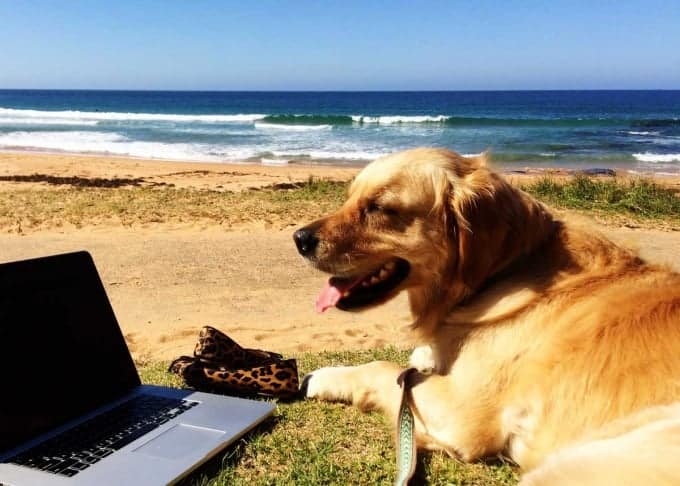
The post Spanish Paella appeared first on RecipeTin Eats.
Read more: recipetineats.com
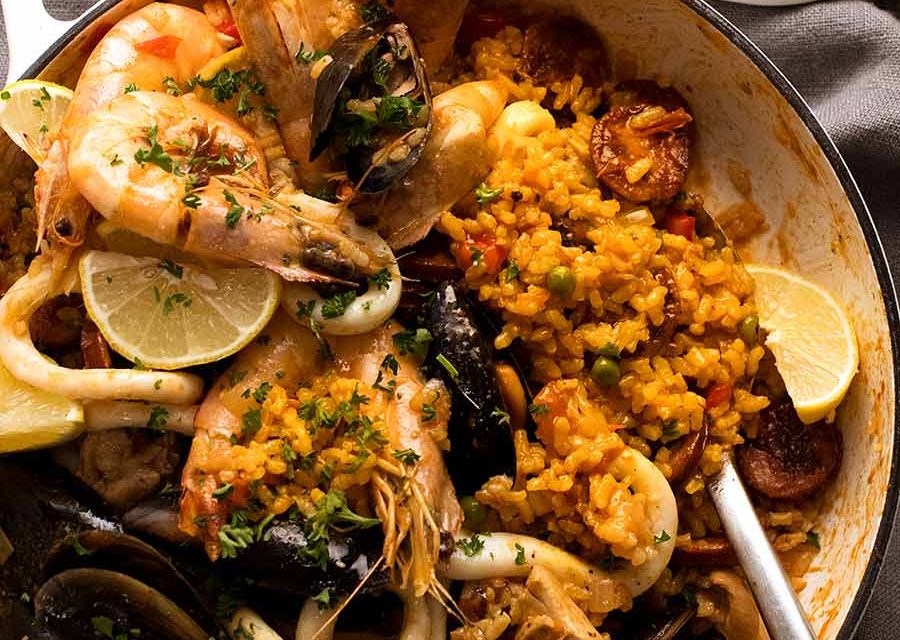

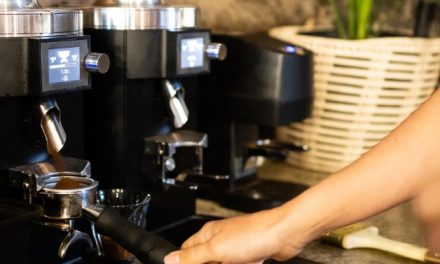



Recent Comments